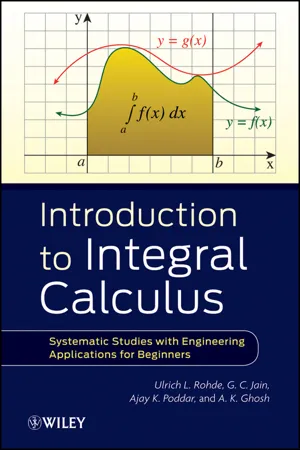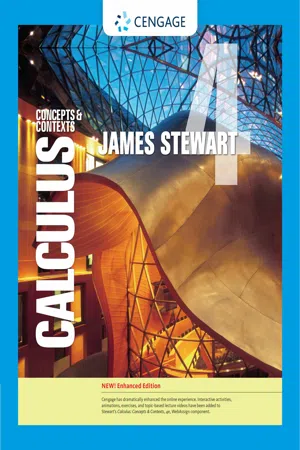Mathematics
Definite Integrals
Definite integrals are a fundamental concept in calculus that represent the accumulation of quantities over a given interval. They are used to find the area under a curve or the net change of a quantity. The definite integral of a function f(x) over the interval [a, b] is denoted by ∫[a, b] f(x) dx and can be interpreted geometrically as the area between the curve and the x-axis.
Written by Perlego with AI-assistance
Related key terms
1 of 5
6 Key excerpts on "Definite Integrals"
- eBook - PDF
Calculus
Single Variable
- Howard Anton, Irl C. Bivens, Stephen Davis(Authors)
- 2022(Publication Date)
- Wiley(Publisher)
273 CHAPTER 5 Applications of the Definite Integral in Geometry, Science, and Engineering In the last chapter we introduced the definite integral as the limit of Riemann sums in the context of finding areas. However, Riemann sums and Definite Integrals have applications that extend far beyond the area problem. In this chapter we will show how Riemann sums and Definite Integrals arise in such problems as finding the volume and surface area of a solid, finding the length of a plane curve, calculating the work done by a force, finding the center of gravity of a planar region, finding the pressure and force exerted by a fluid on a submerged object. Although these problems are diverse, the required calculations can all be approached by the same procedure that we used to find areas—breaking the required calculation into “small parts,” making an approximation for each part, adding the approximations from the parts to produce a Riemann sum that approximates the entire quantity to be calculated, and then taking the limit of the Riemann sums to produce an exact result. Alexander Tolstykh/Shutterstock.com 3D printers generate objects by stacking horizontal layers of the object. A calculus analogue computes the volume of a solid from the areas of its cross sections. 5.1 Area Between Two Curves In the last chapter we showed how to find the area between a curve y = f (x) and an interval on the x-axis. Here we will show how to find the area between two curves. A Review of Riemann Sums Before we consider the problem of finding the area between two curves it will be helpful to review the basic principle that underlies the calculation of area as a definite integral. - eBook - PDF
Calculus
Late Transcendentals
- Howard Anton, Irl C. Bivens, Stephen Davis(Authors)
- 2021(Publication Date)
- Wiley(Publisher)
277 5 Calculus is essential for the computations required to land an astronaut on the Moon. APPLICATIONS OF THE DEFINITE INTEGRAL IN GEOMETRY, SCIENCE, AND ENGINEERING In the last chapter we introduced the definite integral as the limit of Riemann sums in the context of finding areas. However, Riemann sums and Definite Integrals have applications that extend far beyond the area problem. In this chapter we will show how Riemann sums and Definite Integrals arise in such problems as finding the volume and surface area of a solid, finding the length of a plane curve, calculating the work done by a force, finding the center of gravity of a planar region, finding the pressure and force exerted by a fluid on a submerged object. Although these problems are diverse, the required calculations can all be approached by the same procedure that we used to find areas—breaking the required calculation into “small parts,” making an approximation for each part, adding the approximations from the parts to produce a Riemann sum that approximates the entire quantity to be calculated, and then taking the limit of the Riemann sums to produce an exact result. 5.1 AREA BETWEEN TWO CURVES In the last chapter we showed how to find the area between a curve y = f (x) and an interval on the x-axis. Here we will show how to find the area between two curves. A REVIEW OF RIEMANN SUMS Before we consider the problem of finding the area between two curves it will be helpful to review the basic principle that underlies the calculation of area as a definite integral. Recall that if f is continuous and nonnegative on [a, b], then the definite integral for the area A under y = f (x) over the interval [a, b] is obtained in four steps (Figure 5.1.1): Figure 5.1.1 • Divide the interval [a, b] into n subintervals, and use those subintervals to divide the region under the curve y = f (x) into n strips. - eBook - PDF
Introduction to Integral Calculus
Systematic Studies with Engineering Applications for Beginners
- Ulrich L. Rohde, G. C. Jain, Ajay K. Poddar, A. K. Ghosh(Authors)
- 2011(Publication Date)
- Wiley(Publisher)
(ii) The definite integral is the limit of a sum of the form P f ðxÞDx. The definite integral of a function f(x) over an interval from x ¼ a to x ¼ b, where a b, is the common limit of the upper sum (i.e., F n ) and the lower sum (i.e., F n ), if it exists, and is written as Ð b a f ðxÞ dx. In terms of the limiting process, we have P f ðxÞ Dx ! Ð b b f ðxÞ dðxÞ. We take this limiting value as the definition of the definite integral. In particular, the definite integral also stands for the area under a curve, as discussed above. From a subdivision of the interval [a, b] into finite portions of the form Dx, the process of passage to the limit (as Dx ! 0) is suggested by the use of the letter d in place of D. Note: It will be wrong to think that dx is an infinitely small quantity or an infinitesimal (i.e., a variable whose limit is 0) or that the definite integral Ð b a f ðxÞ dx is the sum of an infinite number of infinitely small quantities. This type of thinking is quite misleading and it is a sign of being in the state of confusion. Hence, care must be taken to protect and preserve what we have carried out with precision. We now formally define the area in terms of the definite integral. y f (x) = 2x f ( ) 1 n 1 n 2 n n n f ( ) n –1 n n –1 n x 0 FIGURE 5.13 150 PREPARATION FOR THE DEFINITE INTEGRAL: THE CONCEPT OF AREA 5.4 DEFINITION OF AREA IN TERMS OF THE DEFINITE INTEGRAL Definition: Let f be continuous and non-negative on [a, b], and let R be the region bounded above by the graph of f, below by the x-axis and on the left and right by the lines x ¼ a and x ¼ b. Then, we call R the region between the graph of f and the x-axis on [a, b], and the area of R is defined by Ð b a f ðxÞdx . We emphasize that in the notation for the definite integral Ð b a f ðxÞdx, dx has no independent meaning. It arose originally in connection with the concept of the differential (see Chapter 16 of Part I). - Ronald Harshbarger, James J. Reynolds(Authors)
- 2018(Publication Date)
- Cengage Learning EMEA(Publisher)
Definite Integral Note that for some intervals, values of f may be negative. In this case, the product f (x i *)∆x i will be negative and can be thought of geometrically as a “signed area.” (Remember that area is a positive number.) Thus a definite integral can be thought of geometrically as the sum of signed areas, just as a derivative can be thought of geometrically as the slope of a tangent line. In the case where f (x) is positive for all x from a to b, the definite integral equals the area between the graph of y 5 f (x) and the x-axis. The obvious question is how this definite integral is related to the indefinite integral (the antiderivative) discussed in Chapter 12. The connection between these two concepts is the most important result in calculus because it connects derivatives, inDefinite Integrals, and Definite Integrals. To help see the connection, consider the marginal revenue function R9(x) 5 300 2 0.2x and the revenue function which is the indefinite integral of the marginal function: R(x) 5 2 (300 2 0.2x) dx 5 300x 2 0.1x 2 Figure 13.9 (a) on the next page shows the graph of R(x). Fundamental Theorem of Calculus max Δx i S 0 1 n S ∞ 2 max Δx i S 0 1 n S ∞ 2 Copyright 2019 Cengage Learning. All Rights Reserved. May not be copied, scanned, or duplicated, in whole or in part. Due to electronic rights, some third party content may be suppressed from the eBook and/or eChapter(s). Editorial review has deemed that any suppressed content does not materially affect the overall learning experience. Cengage Learning reserves the right to remove additional content at any time if subsequent rights restrictions require it.- eBook - PDF
- G. M. Fikhtengol'ts, I. N. Sneddon(Authors)
- 2014(Publication Date)
- Pergamon(Publisher)
t This important proposition was first strictly proved by Cauchy (in 1823) for a function continuous in the whole interval. If we remember a geometrical interpretation of the definite integral as an area [Sec. 175], then theorem (12) will be identified with the so-called Newton-Leibniz theorem [Sec. 156]. § 2. PROPERTIES OF Definite Integrals 363 and hence f(x) -εζζμ /(l — A 2 sin 2 Ç?) respectively; they vanish for ψ = 0. Remark. The statements proved in this section can easily be extended to the case of an integral with a variable lower limit, since by (1), b x j/co* = -j/(o*. * b It is evident that the derivative of this integral with respect to x is equal to —f(x) if x is a point of continuity. 364 11. DEFINITE INTEGRAL § 3. Evaluation and transformation of Definite Integrals 184. Evaluation using integral sums. We now give some examples of the evaluation of Definite Integrals by the direct consideration of the limits of the integral sums. - eBook - PDF
Calculus
Concepts and Contexts, Enhanced Edition
- James Stewart(Author)
- 2018(Publication Date)
- Cengage Learning EMEA(Publisher)
The approximation is much closer to the true value than the right endpoint approximation, , shown in Figure 7. Properties of the Definite Integral When we defined the definite integral , we implicitly assumed that . But the definition as a limit of Riemann sums makes sense even if . Notice that if we reverse a and b , then changes from to . Therefore If , then and so We now develop some basic properties of integrals that will help us to evaluate integrals in a simple manner. We assume that f and t are continuous functions. Properties of the Integral 1. , where c is any constant 2. 3. , where c is any constant 4. Property 1 says that the integral of a constant function is the constant times the length of the interval. If and , this is to be expected because is the area of the shaded rectangle in Figure 13. c b a a b c 0 f x c y b a f x t x dx y b a f x dx y b a t x dx y b a cf x dx c y b a f x dx y b a f x t x dx y b a f x dx y b a t x dx y b a c dx c b a y a a f x dx 0 x 0 a b y a b f x dx y b a f x dx a b n b a n x a b a b x b a f x dx FIGURE 12 M¢¸Å_6.7563 0 y 3 x 5 y=˛-6x R 40 6.3998 6.75 M 40 6.7563 FIGURE 13 j c dx=c(b-a) a b 0 y x a b c y=c area =c(b-a) Copyright 2019 Cengage Learning. All Rights Reserved. May not be copied, scanned, or duplicated, in whole or in part. Due to electronic rights, some third party content may be suppressed from the eBook and/or eChapter(s). Editorial review has deemed that any suppressed content does not materially affect the overall learning experience. Cengage Learning reserves the right to remove additional content at any time if subsequent rights restrictions require it. SECTION 5.2 THE DEFINITE INTEGRAL 351 Property 2 says that the integral of a sum is the sum of the integrals. For positive func-tions it says that the area under is the area under plus the area under t . Figure 14 helps us understand why this is true: In view of how graphical addition works, the corre-sponding vertical line segments have equal height.
Index pages curate the most relevant extracts from our library of academic textbooks. They’ve been created using an in-house natural language model (NLM), each adding context and meaning to key research topics.





